The incline bench press is one of the best compound exercises for targeting the chest, shoulders, and triceps. Its main focus is training the upper chest muscles (clavicular head of the pectoralis major).
But there’s one major problem: the front deltoid likes to dominate the movement, if the bench angle is too High (That is in MANY Cases)
So, getting the bench angle correct to train the upper chest effectively is important.
And research has shown that doing the Incline bench press at a 30-degree angle is the best way to work on the upper part of your chest.
Even though 30 degrees may seem like a small angle, it is the proper angle to train your upper pecs and minimize the effect on the anterior deltoid muscles.
If you set the incline bench press angle to 60 degrees, which people will use for an incline bench press, then you’re going to shift the focus from the upper chest to the anterior deltoid.
The higher the bench’s angle, the more the exercise emphasizes the shoulders, hence the need to find that sweet spot for optimal chest engagement.
Want to take your gains to the next level? Discover your daily calorie needs with our free TDEE calculator.
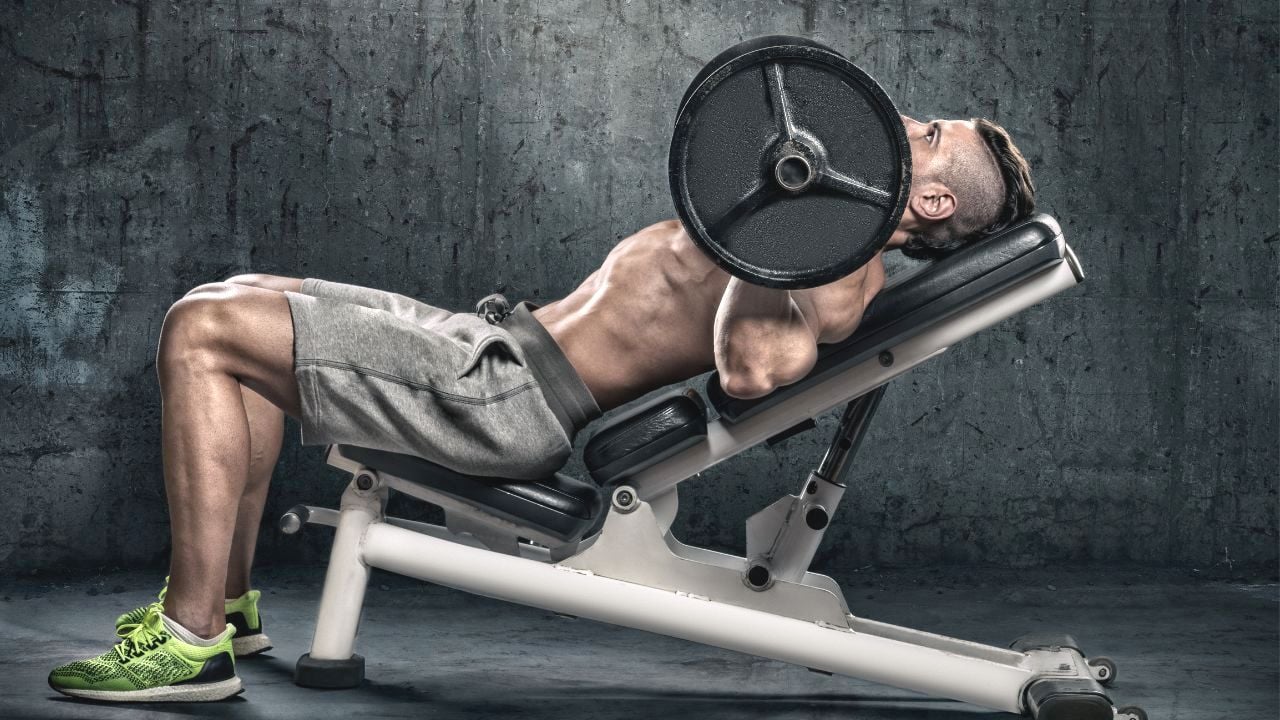
- Right Angle Of Incline Chest Press for You
- 30–45 Degrees (Standard Recommendation)
- 15–30 Degrees
- Above 45 Degrees (e.g., 50-60+ Degrees)
- Incline Chest Press Muscles Worked
- Incline Bench Press Variations
- 1. Barbell Incline Bench Press
- 2. Incline Dumbbell Press
- 3. Smith Machine Incline Press
- 4. Incline Cable Bench Press
- References
Right Angle Of Incline Chest Press for You
While no single angle is perfect for everyone, research and practical experience point to a specific range that best targets the upper chest (clavicular head of the pectoralis major) during the incline bench press.
Picking the right angle in this range is important. It helps you get the most out of your muscle activation while keeping unwanted stress to a minimum and avoiding distractions to other muscle groups.
30–45 Degrees (Standard Recommendation)
This range is widely accepted as the most effective for training the upper chest fibres.
Any incline, compared to a flat bench, shifts some focus upwards, but the 30-45 degree zone is where this shift becomes significant enough to specifically target the clavicular head for growth.
For many lifters, a 30-degree incline hits the sweet spot. EMG studies (which measure muscle electrical activity) often show high upper chest activation at this angle.
It provides a good balance between stimulating the upper chest and allowing you to still lift a heavy load.
The steeper the angle, the more the anterior (front) deltoids get involved. At 45 degrees, the front delts contribute significantly to the movement.
15–30 Degrees
It will still shift the focus to upper chest emphasis, but it isn’t quite as pronounced as at slightly higher angles. Angles in this lower range tend to recruit a bit more of the overall pectoral muscle.
Some weightlifters find lower inclines more comfortable on their shoulder joints. They can lift slightly heavier weights at 15–30 degrees compared to 45 degrees.
It’s an excellent place to start if you’re new to incline pressing or if higher angles cause shoulder discomfort.
Above 45 Degrees (e.g., 50-60+ Degrees)
Once you go significantly beyond 45 degrees, the exercise biomechanically transforms. The primary movers become the anterior deltoids, with the upper chest playing a much smaller, secondary role.
It essentially becomes an incline shoulder press variation, not an effective chest exercise.
Avoid angles above 45 degrees if your goal is primarily upper chest development.

Incline Chest Press Muscles Worked
The incline bench press primarily works the upper pectoralis major muscles and targets the main pec muscle.
The incline chest press involves several synergist muscles, these muscles include,
- Rhomboids,
- Anterior deltoids, and
- Triceps brachii,
- Latissimus dorsi.
A handful of other muscles work or play the role of stabilizer muscles, including your
- Biceps brachii,
- Brachialis,
- Wrist flexors.
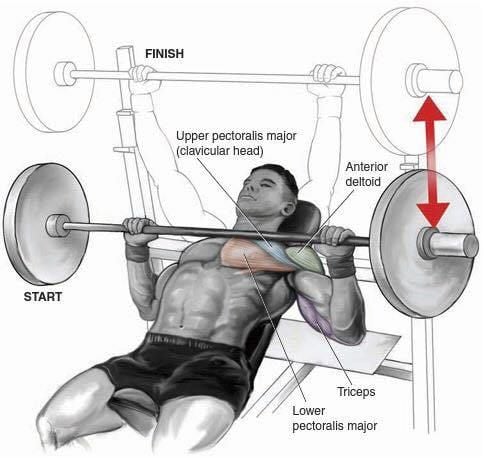
Incline Bench Press Variations
The standard barbell incline bench press is a great mass and strength builder, but don’t be afraid to switch it up. Variations like the incline dumbbell press, incline smith machine press, and incline cable press offer new angles of attack for upper chest and shoulder growth.
Changing your grip width or arm position further alters the stimulus. Work these incline bench press variations into your chest routine to target different muscle fibers, enhance mind-muscle connection, and bust through plateaus.
1. Barbell Incline Bench Press
Barbell incline bench press is a compound upper-body exercise that targets multiple muscle groups, including the chest (upper pec), shoulders, and triceps.
The barbell allows for greater stability compared to dumbbells, which means you can generally lift heavier weights.
When you lift heavier weights with good form over time, your muscle growth (hypertrophy) and strength gains improve. There’s a certain raw power you can build with the barbell.

How To Do
- Set an adjustable bench at an incline of around 30–45 degrees.
- Lie back on the bench with your feet flat on the floor.
- Retract your shoulder blades (pull them back and down). This creates a stable base and protects your shoulders. Maintain a slight, natural arch in your lower back, but keep your glutes on the bench.
- Grasp the barbell with a grip slightly wider than shoulder-width apart.
- Grip the barbell with your hands slightly wider than shoulder-width apart.
- Slowly lower the barbell towards your mid-chest. Lower it under control (2-3 seconds down). This eccentric phase is crucial for muscle growth and injury prevention.
- Keep your elbows tucked slightly (maybe 45-60 degrees relative to your torso), not flared out wide like wings.
- Pause briefly, then push the barbell back up to the starting position. Do 8–10 reps.
Know More: Barbell Chest Exercises For Bigger And Stronger Pecs
2. Incline Dumbbell Press
It targets the upper chest muscles similarly to the barbell incline bench press, but offers some unique benefits.
Unlike a barbell, which has a fixed path, dumbbells allow your hands and elbows to move in a more natural arc and also allow for a greater range of motion at both the bottom and top of the movement.
As you press up, your hands can drift slightly inwards towards each other. This horizontal adduction (bringing the arms across the body) component is a primary function of the pecs.
The dumbbell variation is one of my favourites, as it gives me a good stretch and strong peak contraction.
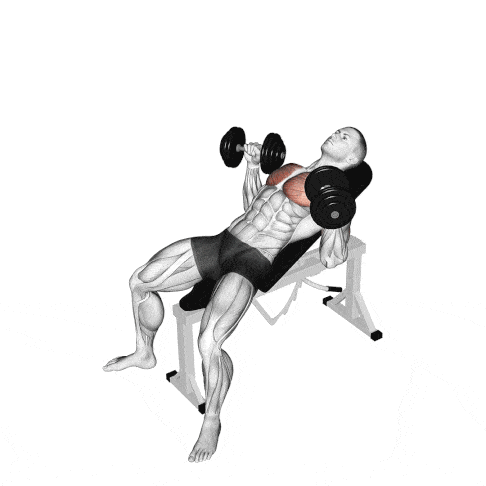
How To Do
- Set an adjustable bench to an incline angle between 30–45 degrees.
- Safely get the dumbbells to the starting position (chest level, up one at a time).
- Plant your feet, retract your shoulder blades firmly against the bench, and engage your core.
- Hold them straight above your shoulders with palms facing forward.
- Lower the dumbbells down slowly until they are even with your chest.
- Once the dumbbells lightly touch your chest, reverse the motion to the starting position.
- Squeeze your chest muscles at the top and hold for a second.
3. Smith Machine Incline Press
The Smith machine dictates the path for you, unlike barbells and dumbbells, where you control the bar’s trajectory in three dimensions.
This changes the biomechanics significantly:
- As the machine stabilises the bar’s forward/backwards and side-to-side movement, so its reduces the involvement of smaller stabiliser muscles
- The resistance feels very consistent throughout the range of motion because there’s no balancing act involved.
- The presence of safety catches on the Smith machine allows for independent lifting without the need for a spotter.
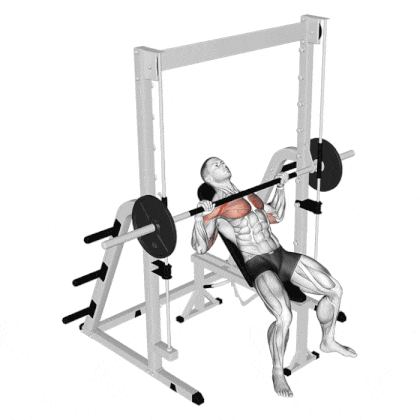
How To Do
- Set your incline bench (again, 15-45 degrees, often starting at 30) under the bar.
- Lie down and carefully determine where the bar path aligns with your upper chest.
- Once positioned, engage your core and retract your shoulder blades down against the bench. Maintain a slight natural low back arch.
- Grasp the barbell with an overhand grip slightly wider than shoulder-width apart.
- Unrack the barbell by lifting it off the safety catches and holding it directly above your chest.
- Lower the barbell slowly and under control until it touches your upper chest.
- Push the barbell back up along the same path until your arms are fully extended, but avoid locking out your elbows.
4. Incline Cable Bench Press
The Incline cable bench press has unique benefits, such as precision, constant tension, and achieving an incredible peak contraction in the upper chest.
In barbell and incline dumbbell bench presses, the resistance is directly downward, and your triceps brachii take over much of the force from your chest at the top of the press.
In contrast, the incline cable bench press maintains more focus on your upper pectoralis major throughout the movement.
The resistance comes from an angle, so you have to push the stirrups upward and pull them inward. That constant inward and upward tension allows you to concentrate on driving the muscle fibers together.
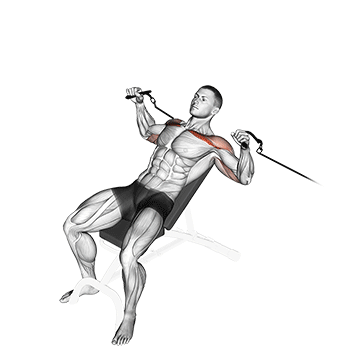
How To Do
- Set an incline bench at a 30 to 45-degree angle.
- Attach stirrup handles to the low pulleys and lie down on the bench with your feet flat on the floor.
- Exhale as you extend your elbows up to move your arms up and inwards until your hands meet.
- Squeeze your upper chest at the top of the movement.
- Then inhale as you slowly release back to the starting position.
References
- Influence of bench angle on upper extremity muscular activation during bench press exercise. Lauver, J. D., Cayot, T. E., & Scheuermann, B. W. (2015). European Journal of Sport Science, 16(3), 309-316. doi:10.1080/17461391.2015.1022605. URL: https://www.tandfonline.com/doi/full/10.1080/17461391.2015.1022605, accessed on 24.08.2020
- Rodríguez-Ridao, D., Antequera-Vique, J. A., Martín-Fuentes, I., & Muyor, J. M. (2020). Effect of Five Bench Inclinations on the Electromyographic Activity of the Pectoralis Major, Anterior Deltoid, and Triceps Brachii during the Bench Press Exercise. International Journal of Environmental Research and Public Health, 17(19).
- An Electromyography Analysis of 3 Muscles Surrounding the Shoulder Joint During the Performance of a Chest Press Exercise at Several Angles. Trebs, A. A., Brandenburg, J. P., & Pitney, W. A. (2010). Journal of Strength and Conditioning Research, 24(7), 1925-1930. doi:10.1519/jsc.0b013e3181ddfae7

Manish is a NASM-certified fitness and nutrition coach with over 10 years of experience in weight lifting and fat loss fitness coaching. He specializes in gym-based training and has a lot of knowledge about exercise, lifting technique, biomechanics, and more.
Through “Fit Life Regime,” he generously shares the insights he’s gained over a decade in the field. His goal is to equip others with the knowledge to start their own fitness journey.
